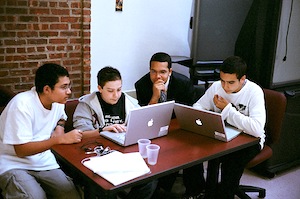 Every teacher who has attempted to integrate technology into the classroom knows that getting parents on board can sometimes be a challenge.
Every teacher who has attempted to integrate technology into the classroom knows that getting parents on board can sometimes be a challenge.
It’s not uncommon for the parent of a struggling child to be on the phone with you asking questions like: “Why do you need to use technology to teach math/social studies/English/biology?” or “This is an AP history class — not computer science!”
Your efforts to engage students and develop important 21st century skills can become the scapegoat explanation for problems that have nothing to do with tech.
So, how do we as educators get these parents into our corner? Here are some strategies I’ve used successfully to gain parent buy-in.
Start Early
The first time that parents hear about technology use in the classroom should not be when that child goes home with a tech-related assignment in hand. Instead, start early. “Back to School Night” is a great time to introduce the concept of technology integration to parents. You don’t need to go into detail: a few words about the importance of technology in the “real world” and the opportunity it allows for collaboration and communication can be enough to get parents excited. This can also be a great time to introduce them to digital citizenship and digital portfolios.
Emphasize Skills
 Instead of emphasizing the content side of technology and the Internet, focus on skill sets and career readiness!
Instead of emphasizing the content side of technology and the Internet, focus on skill sets and career readiness!
Using creative hardware and software, students learn to adapt to different tools, harness social media, solve challenging problems, overcome obstacles, and showcase their knowledge and cutting edge skills.
While a parent might balk at their child learning to “make a movie,” they all want their child to develop core skill-sets that will help them both in school and “the real world” of college and careers.
Keep Up the Communication
At the start of every new project, send a note out to parents about what you will be doing in your classroom, including your technology plans. Outline the skills that their student will be developing and be sure to invite questions and promise follow-up. Most parents like to stay in the loop and know what’s happening in the classroom. Trust me, they will appreciate the effort. Most important: keep it brief! A short email of just a few lines is more likely to be read than a two-page treatise on pedagogical theory. Just keep it simple and to the point.
Be Transparent
Be open to sending parents your project instructions and any rubric you will use to assess their child’s work. Like it or not, parents care about grades. If you can show them what you will be looking for and exactly how their student will be graded, they’ll feel more comfortable with the project as a whole.
Enlist the Aid of Your Administrators
Bring administration into the loop. As much as it may bother teachers, parents will often go to administrators first with any concerns about your classroom. If your principal knows about the assignment, the learning objectives, the grading rubric, and the pedagogical theory behind your approach, they will have your back with the parents. This can only work to your advantage as you push beyond traditional models of teaching.
Provide a Lot of Time in Class
Not all students have access to a computer or the Internet at home. Provide as much time in class to work on the assignment as possible. Not only will this limit their out-of-class work, it will make you readily available to students who are struggling with the nuts and bolts of their assignments. Parents are more likely to feel okay with a project if they know their child has a lot of face time with their teacher.
Don’t Grade “the Tech”
 Whatever rubric you develop, make sure that you aren’t grading “the tech.” Focus on the skills they develop, the effort they make, the research they do, etc. A student with a lot of fancy equipment and know-how will produce a more polished product than a student with virtually no resources who is developing new skills.
Whatever rubric you develop, make sure that you aren’t grading “the tech.” Focus on the skills they develop, the effort they make, the research they do, etc. A student with a lot of fancy equipment and know-how will produce a more polished product than a student with virtually no resources who is developing new skills.
And focus on “traditional” skills as well as new and innovative ones. Grade appropriately, but grade the skills and development, not the bells and whistles.
Follow Up with Parents
Keep parents in the loop throughout the year. If their child has just finished an impressive project, drop them a note and suggest that they sit down to see the finished product with their child. Even the most reluctant parents tend to be excited when they see the work their student has produced.
Even if you follow all of these steps to the T, you likely won’t get 100% of parents to buy into your digitally infused pedagogy. This is where the teamwork mindset you develop with your administration can become a true asset, as you present a united front to parents about the valuable education their child is receiving in your technology-savvy classroom. Often, even the most reluctant parent can be brought around if they can be convinced that educators in their school are making well-thought-out decisions with the best interests of their child in mind.
Photo 1: Talladega County Schools
Photo 2: Creative Commons
Photo 3: Bigstock
Jennifer Carey
Latest posts by Jennifer Carey (see all)
- How to Get Hesitant Teachers to Use Educational Technology - August 7, 2019
- Those Terms of Service on Popular Websites DO Matter! - April 22, 2014
- How to Infuse Digital Literacy Throughout the Curriculum - March 26, 2014


Why are we concerned with the parent perspective? Are the kids enjoying it? If yes, then continue; at the end of the day it is THEIR education, not ours & not their parents.
Zep,
Are you serious? If teachers only used the criteria of student enjoyment and pleasure on which to build lessons, schools would only create students who are skilled in self-centered hedonism. We owe students more than indulging their (and perhaps teachers’) craving for instant gratification.
Boo
As educators, we are morally (as well as legally) obliged to engage parents. We can choose to make that relationship challenging and combative or work to make it inclusive and constructive. I (and many other educators) choose the latter.
Also, as much as we would like to believe that children all of the time focus on education and what it can do for them, they are children. Children do not always choose what is best for them and at that point is it the role of adults (especially parents & guardians as well as teachers) to step in and direct them.